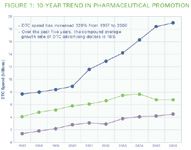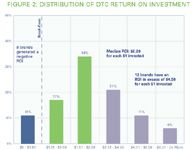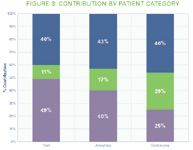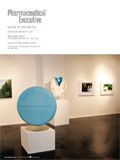DTC Grows Up
With Exprience and A new means of measuring impact on patient behavior, branders have never been in a better position to make their strategies work
RESEARCHERS call it the "10-year rule"—the notion that mastery in any complex skill comes after 10 years of intensive study, diligent practice, and constant trial and error.
Well, it's been 10 years since the Food and Drug Administration (FDA) relaxed its guidelines on advertising pharmaceuticals in broadcast media. And, true to the rule, not only have direct-to-consumer (DTC) strategies and practices matured, but the methods with which companies can gauge their success have also come of age.
But what does it mean for the current state of DTC pharmaceutical advertising when it comes to spending trends, return-on-investment standards, and new measurement options? And where is DTC likely to go in the next five years?

Figure 1
GROWING UP HEALTHY
Spending on DTC advertising has risen fairly steadily over the past 10 years—and less erratically than spending on samples and detailing.
In 2006, the industry's total DTC expenditure of $4.5 billion represented a 220 percent increase over the 1997 expenditure of $1.4 billion. Meanwhile, the cost of sampling skyrocketed from $7.7 billion in 1997 to $19 billion in 2006, and detailing budgets rose from $4.1 billion in 1997 to a high of $7.7 billion in 2004. They have since leveled out at $6.8 billion. From 2000 to 2006, DTC channels consistently gained ground in the marketing mix as focus shifted away from physician detailing. In that time, the largest spending increases were for TV advertising and, more recently, for magazine exposures.
SPENDING TODAY
Of the industry's total DTC expenditure of $4.5 billion in 2006, the lion's share ($1.6 billion) went to the broadcast networks, while the smallest portion went to the Internet ($163 million).
More telling, perhaps, is the change over the prior year. In 2006, investment in broadcast media rose 9.4 percent; in cable, 6.1 percent; in print, 24.7 percent; and in the Internet, 9.5 percent.
Spending was very concentrated. The 10 most-advertised brands accounted for 37 percent of the industry's DTC spending (see figure 2). The most money was lavished on Lunesta, Sepracor's sleep aid, which had a DTC advertising budget of $300 million.

Figure 2
In researching more than 500 US product launches, IMS Health, a consulting and data services company, found that for blockbuster brands, DTC spending peaked in the first year post-launch.
Interestingly, that peak is shifting further away from launch, as that many companies are following PhRMA's guidelines to educate physicians about new products before advertising them to consumers. To fill the void, companies are devoting more of their DTC mix to unbranded, unpaid advertising during the year before and after launch—activities driven by PR and key opinion leaders to promote disease awareness and "prime" the market.
DTC CONTRIBUTION?
IMS's normative database of the promotional effort and market response across five years for hundreds of brands in a broad range of therapeutic categories is kept up-to-date. It currently encompasses many newly launched brands. It provides a way to monitor DTC trends, benchmark performance, and observe the best practices.
A recent analysis by IMS of 68 brands found that for the most heavily advertised products, DTC advertising typically generated around 4 to 9 percent of their new prescription volume, whereas samples accounted for 7.8 percent, details for 21.1 percent, and the base (or, what could be expected with no promotion) for the remaining 67.7 percent.
DTC's contribution, while small in relative terms, is nonetheless significant in absolute terms; with a $2 billion brand, for instance, a 3 percent contribution to new prescriptions equates to $60 million in sales.
It is also clear that each channel has a unique role in the promotion process and in maintaining the balance between garnering new patient starts and supporting therapy continuation. TV advertising tends to drive a sharp increase in new therapy starts for the first week or two after exposure, whereas print media have a longer, more gradual impact in maintaining a brand's patient base.
RETURN ON INVESTMENT
The median return on investment (ROI) for those brands employing DTC advertising in the IMS normative database is $2.20 for each $1 invested, and the majority of these brands realized a positive ROI on by the second year of a sustained campaign (see figure 2). Several factors affect a given product's ROI:
- Degree to which the market is controlled by managed care
- Size of the brand and the market
- The refill rates in the therapeutic class
- Price of the brand.
In all fairness, DTC advertising's ROI should be measured only on that portion of the market that is promotionally sensitive.
In some markets, as much as 30 percent is "locked up" by managed care formularies. On the other hand, reaching the patients in the open-access plans favored by labor unions (an estimated 50 million consumers) is worthwhile.
BIGGEST BANG
In general, the best ROIs are seen for products that can command premium prices in sizeable markets (such as statins and asthma medications) where patients tend to stay on therapy for a long time.
Products such as allergy medications, for which there is a lot of market variation and patients are not persistent in their therapy, tend to achieve ROIs in the midrange.
Products achieving ROIs on the low end of the spectrum tend to fall into classes like dermatology and weight loss, in which prices and persistency are both low.
Note that a high ROI ratio does not necessarily spell DTC advertising success. DTC advertising often drives performance across brands in more consumer-driven and/or specialty markets.
For better or worse, unbranded DTC advertising spreads a halo over the entire market that is typically twice as strong as that which is cast by the sponsor's own brand. And the largest brands in a class reap the biggest benefit. In one case, in the depression market, an unbranded ad contributed 1.5 percent of new prescriptions to the entire market and .6 percent to the sponsor.
IMPACT ON PATIENTS
While it is undoubtedly valuable to know if a DTC campaign succeeded in increasing a product's prescription volume or market share, it is now possible to evaluate the success of a DTC campaign by its impact on patient behavior.
By tapping into anonymized, patient-level data (APLD), brand managers can determine:
- The ROI of the campaign over the patient's lifetime, which is vitally important in chronic therapy areas
- Whether the ads are expanding the market, as measured by NBRxs, not NRxs
- When patients are most vulnerable to switching brands
- How the promotion impacts consumer loyalty and patient persistence
- Whether the promotion is reaching the most appropriate types of patients and working according to the strategy.
A comparison of APLD from before and after exposure to advertising (or between test and control groups) can demonstrate whether a campaign is performing as intended—that is, reaching the right groups of patients, conveying the right message, and capturing the expected share of the dynamic market. Such studies can be used to assess the effectiveness of newer patient-directed programs in addition to more traditional channels.

Figure 3
A DTC strategy should be designed to encourage product trial, adoption, and long-term compliance and persistence. IMS evaluated DTC effectiveness according to its impact across these three stages of patient behavior. An analysis across multiple brands shows TV and print were effective in raising awareness and promoting product trial, driving 60 percent of the new patients trying a new brand (see figure 3).
Meanwhile, detailing and the associated product messaging drove adherence and compliance. The contributions differed across brands and therapy areas; DTC contributes much more in consumer-driven markets (e.g., insomnia) than in critical-need markets (e.g., oncology).

DTC: The Next Five Years
While new legislation could bring additional challenges, advertisers have never been in a better position to make their strategies work. They have the benefit of 10 years of experience in reaching out to consumers and now also have a new means of measuring the direct impact they're having on patient behavior.
Tim Kelly is the promotion management practice leader at IMS Health Management Consulting. Reach him at tkelly@us.imshealth.com
The Misinformation Maze: Navigating Public Health in the Digital Age
March 11th 2025Jennifer Butler, chief commercial officer of Pleio, discusses misinformation's threat to public health, where patients are turning for trustworthy health information, the industry's pivot to peer-to-patient strategies to educate patients, and more.
Navigating Distrust: Pharma in the Age of Social Media
February 18th 2025Ian Baer, Founder and CEO of Sooth, discusses how the growing distrust in social media will impact industry marketing strategies and the relationships between pharmaceutical companies and the patients they aim to serve. He also explains dark social, how to combat misinformation, closing the trust gap, and more.
